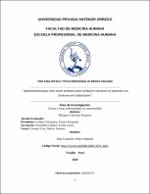Hiperproteinorraquia como factor predictivo para ventilación mecánica en pacientes con Síndrome de Guillain Barré

View/
Download
(application/pdf: 812.3Kb)
(application/pdf: 812.3Kb)
Date
2022Author(s)
Chinchay Ramírez, Milagros
Metadata
Show full item recordAbstract
Determinar si la hiperproteinorraquia es un factor predictivo para
ventilación mecánica en pacientes con Síndrome de Guillain Barré.
Material y Métodos: Se realizó un estudio observacional, analítico, comparativo,
transversal y retrospectivo (por recolección de datos), participaron 76 pacientes con
diagnóstico de SGB que acudieron a hospitales III-1- Provincia Trujillo en el periodo
2000-2019. Para ver la relación entre las características y la VM se usó la prueba
T student para variables cuantitativas y Chi cuadrado de Pearson (X2
) para
cualitativas.
Resultados: Diecinueve (25%) pacientes reunieron los criterios para VM y 57
pacientes no lo hicieron. La proporción de pacientes con SGB con
hiperproteinorraquia y VM fue 84,21% y los que tuvieron hiperproteinorraquia y no
fueron a VM fue 71,93%. La proporción de pacientes con proteínas en LCR menor
de 40mg/dl que fueron a VM fue 15,79%, frente a los que no fueron a VM 28,07%,
mostrando que la variable hiperproteinorraquia no es un factor predictor para VM en
pacientes con SGB (p = 0,284).
Conclusión: La hiperproteinorraquia no es un factor predictivo para ventilación
mecánica en pacientes con Síndrome de Guillian Barré To determine if hyperproteinorrachia is a predictive factor for mechanical
ventilation. in patients with Guillain Barré Syndrome.
Material and Methods: An observational, analytical, comparative, cross-sectional
and retrospective study (by data collection) was carried out., 76 patients with
diagnosis of GBS, who attended hospitals III-1-Trujillo in the period 2000-2019
participated. To see the relationship between the characteristics and the VM, the
student T test was used for quantitative variables and Pearson's Chi square (X2
) for
qualitative variables.
Results: Nineteen (25%) patients met the criteria for MV and 57 patients did not. The
proportion of patients with GBS with hyperproteinorrachia and MV was 84.21% and
those who had hyperproteinorrachia and did not go to MV were 71.93%. The
proportion of patients with CSF proteins less than 40mg / dl who went to MV was
15.79%, compared to those who did not go to MV 28.07%, showing that the
hyperproteinorrachy variable is not a predictor for VM in GBS patients (p = 0.284).
Conclusion: Hyperproteinorrachia is not a predictive factor for mechanical ventilation
in patients with Guillian Barré syndrome
Collections
- Medicina Humana [2969]

